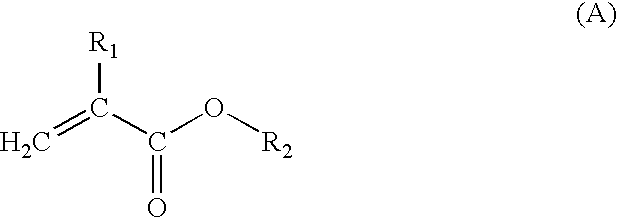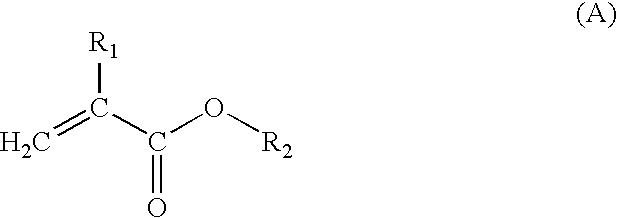Acrylic resin
a technology of acrylic resin and acrylic resin, which is applied in the direction of synthetic resin layered products, film/foil adhesives, protective garments, etc., can solve the problems of light leakage, peeling between, and light leakage in tn liquid crystal cells (tft), and achieve the effect of improving durability
- Summary
- Abstract
- Description
- Claims
- Application Information
AI Technical Summary
Benefits of technology
Problems solved by technology
Method used
Image
Examples
example 2
Polymerization Example 2
[0125] The reaction was completed in the same manner as in Polymerization Example 1 except that parts of monomer (a), (b), (c) and (d) used were as illustrated in Table 1. The results are illustrated in Table 1.
example 3
Polymerization Example 3
[0126] Into a reactor equipped with a cooling tube, nitrogen introduction tube, thermometer and stirrer was charged 222 parts of ethyl acetate, and air in the apparatus was purged with a nitrogen gas (substantially no oxygen contained in the apparatus), then the inner temperature was raised to 75° C. A solution prepared by dissolving 0.55 part of azobisisobutyronitrile (hereinafter, referred to as AIBN) in 12.5 parts of ethyl acetate was added to the reactor while keeping the inner temperature at 69 to 71° C., then, a mixed solution of 92.2 parts of butyl acrylate as a monomer (a) and 7.8 parts of isobornyl acrylate as a monomer (b) was dropped into the reactor over 3 hours. Thereafter, the mixture was thermally insulted at 69 to 71° C. for 5 hours, to complete the reaction. The results are illustrated in Table 1.
example 4
Polymerization Example 4
[0127] The reaction was completed in the same manner as in Polymerization Example 1 except that parts of monomer (a) and (b) used were as illustrated in Table 1. The results are illustrated in Table 1.
PUM
| Property | Measurement | Unit |
|---|---|---|
| Percent by mass | aaaaa | aaaaa |
| Percent by mass | aaaaa | aaaaa |
| Percent by mass | aaaaa | aaaaa |
Abstract
Description
Claims
Application Information
 Login to View More
Login to View More - R&D
- Intellectual Property
- Life Sciences
- Materials
- Tech Scout
- Unparalleled Data Quality
- Higher Quality Content
- 60% Fewer Hallucinations
Browse by: Latest US Patents, China's latest patents, Technical Efficacy Thesaurus, Application Domain, Technology Topic, Popular Technical Reports.
© 2025 PatSnap. All rights reserved.Legal|Privacy policy|Modern Slavery Act Transparency Statement|Sitemap|About US| Contact US: help@patsnap.com



